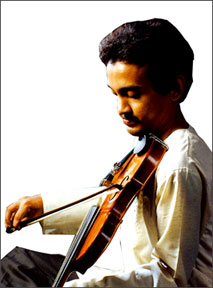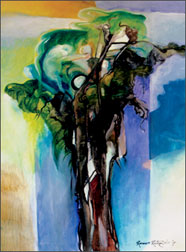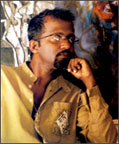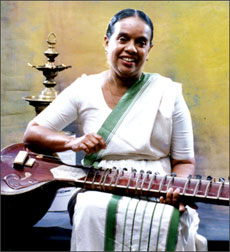Arts
Spell of classical music that enthralled the audience
Thusara Sara - a classical Hindustani concert by Dr.
Thushara Ratnayake:
by Indeewara Thilakarathne and Ranga Chandrarathne
[email protected]
 As the curtain rose at the Ananda College auditorium, the singular
figure of Dr. Thushara Ratnayake appeared on the centre stage against
the back drop of soothing atmosphere especially created for the
performance. The air of calmness with the projected image of Taj Mahal
quintessentially reminded the spectators of the rich cultural legacy of
India. As the curtain rose at the Ananda College auditorium, the singular
figure of Dr. Thushara Ratnayake appeared on the centre stage against
the back drop of soothing atmosphere especially created for the
performance. The air of calmness with the projected image of Taj Mahal
quintessentially reminded the spectators of the rich cultural legacy of
India.
As Hindustani classical music is considered highly-evolved form of
music which is intended for the gods, the atmosphere was also in keeping
with soothing mood of the music.
It was noticeable even from the stage decorations such as strewn
flowers on the stage, that the organizers had attempted to make the
atmosphere as devotional as possible. Compared with the Western music,
Hindustani classical music is monotonous which enabled the performer to
go into a kind of meditation and to convey that mood, gradually, to the
audience.
In accordance with the tradition, the concert commenced with a
Sarasvathi Vandana, a devotional mantra to the goddess of arts,
Sarasvathi. This once again reminds us of the close links between the
Hindustani music and religion. For the element of devotion is a
recurrent characteristic manifested amply in the concert.
The first item of the concert was a solo violin performance based on
Rag Jog. It commenced with the introduction, Alaap, then it joined with
Tabla on nine beat matta Taal and Theen Taal (16 beat) and came to its
climax with Jala. Besides the sheer mastery on the part of the
performer, it highlighted the highly evolved nature of Hindustani
classical music.
This item was a classical violin play that commenced with Alaap, an
introduction with salient characteristic of the Rag Jog.
The climax of the performance, Jala epitomised the mastery that Dr.
Thushara Ratnayake gained from the years of meticulous practice and his
knowledge of Hindustani classical music.
The second piece was a semi-classical performance based on the Rag
Mishra Pahadi which is a Bhajani Dhoon. This item was played with the
famous Dhoon style.
One of the attractive items was the duet-violin and flute.
For this piece, veteran flutist Hemapala Perera joined on flute. It
was based on Rag Mishra Sivranjani.
Though it was a Dhoon style performance, here unlike in classical
tradition two instruments were used for the performance.
Hemapala Perera's Sri Lankan music touch would have added colour to
this item. It was a semi-classical item. Hemapala Perera who is famous
for his classical as well as popular music performances, with his flute
mesmerized the audience. The flute added soothing undertone to the piece
while it was enhanced by the accomplished Tablist Shantha Senarath Yapa.
Yapa should be commended for his mastery performance as it was very
difficult exercise for a Tablist to accompany a classical music
performance.
Rag Mala was the performance based on Rag Jai Jai Wanthi which is a
complex Rag, consisting of several ragas such as Khamaja, Kafi and in
addition it contains features of Horat, Nut, gaud, bilawal. For Rag Mala,
Dr. Thushara Ratnayake was accompanied by his students.
The performance which commenced with Rag Jai Jai Wanthi and then
shifted on to Ragas Kalawathi, Jana sammohini, Vachasththi, Handhwani,
Bhoopali, shuddha kalyani, Yaman Kalyani and joined with Jai Jai Wanthi.
As for the name sake, Rag Mala is garland of Ragas with different
colours. Though the structure has been rehearsed, the piece was an
impromptu item. Rag Mala is also traditionally used for solo
performances. Perhaps, it was for the first time that Rag Mala was used
for a group performance.
This was one of the important items which demonstrated in no
uncertain terms the intricacies of Hindustani music and the kind of zest
that it generated especially from shifting one Raga to another.
As aptly named Rag Mala, it was a garland of ragas with multiple
tone-colours. Such subtleties can only come from a master musician. One
of the singular aspects of the concert was its pure classical base from
which sprang a rage of zests that are unique to Hindustani classical
music.
All in the entire concert offered a rich insight into Hindustani
classical music and fascinating facets of it. However, the mood was
somewhat distracted by Hemapala Perera's demonstration of popular songs
which reminded of music emanating from a tea boutique. It was
inappropriate at that stage when the concert came to its climax.
The atmosphere of soothing classical music which spell bounded the
audience was proverbially gone with the wind, with demonstration of
popular song even though with the intention of highlighting the fact
that those songs were based on Raga.
Though this may have been suitable for a Paduru Party (mini-concert
on the mat), it was not appropriate for the occasion.
The unwanted speech which not only cost a duet of guitar and violin
but also smeared mud on the concert adding the gory elements of stinking
student's politics that blighted the Sri Lankan system of universities.
It is pathetic that students' leader made use of a classical music
concert to criticize Minister of Education. Above all Thushara Sara
dispelled the widespread myth that classical music should always be
associated with funerals and melancholy moods. The large audience which
appreciated the concert throughout the evening testified that there is
an audience for classical music in Sri Lanka.
However, it should be mentioned here that in order to propagate
classical music in Sri Lanka, it is imperative that Sri Lankan media
should give more space for classical music.
Dr. Thushara Ratnayake, Hemapala Perera and Shantha Senarath Yapa
should deserve a big applause for presenting an evening of divine music.

Symphony of colours
 Symphony of Colours, a sole exhibition of paintings by Kumara
Ratnayake will be held at Lionel Wendt Art gallery from March 28 to
March 30, 2008. Kumara, who hails from Pasyala, is fascinated by the
rural landscape and humanscape and with his brush strokes captures the
quintessential characteristic of life in village; joys and sorrows of
the village folks. Symphony of Colours, a sole exhibition of paintings by Kumara
Ratnayake will be held at Lionel Wendt Art gallery from March 28 to
March 30, 2008. Kumara, who hails from Pasyala, is fascinated by the
rural landscape and humanscape and with his brush strokes captures the
quintessential characteristic of life in village; joys and sorrows of
the village folks.
"Sri Lankan sense and Sri Lankan lifestyles are what inspired most"
says Kumara. Kumara's paintings depict his surroundings. He is also fond
of using bright coloures and diverse hues to convey his feelings across
the canvas.
(IT)
 A solo-performance by Nanda Malani in London A solo-performance by Nanda Malani in London
"Shravana Aradhana", a solo performance by veteran singer Nanda
Malani will be held in Camden hall in London. The concert was organised
by Nalanda College Old Boys Association in London.
Nanda Malani is accompanied by Rohana Weerasinghe, D.D Gunasena,
Tissa Siri Perera, Mahendra Pasqual and Dananjaya Somasiri.
Nanda Malani, who became the first female vocalist performed in
London, is conducting the concert for the fourth time. (RC) |
